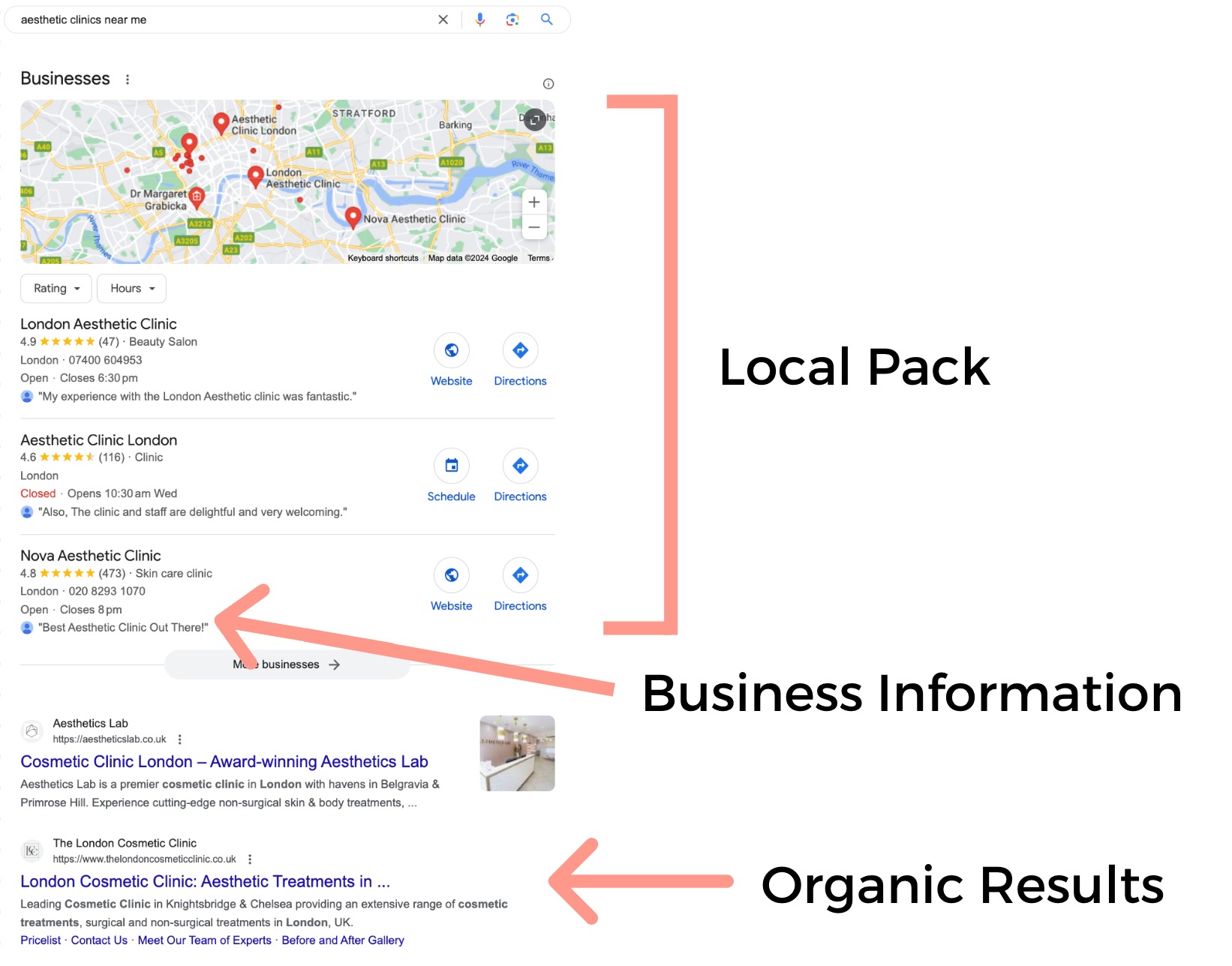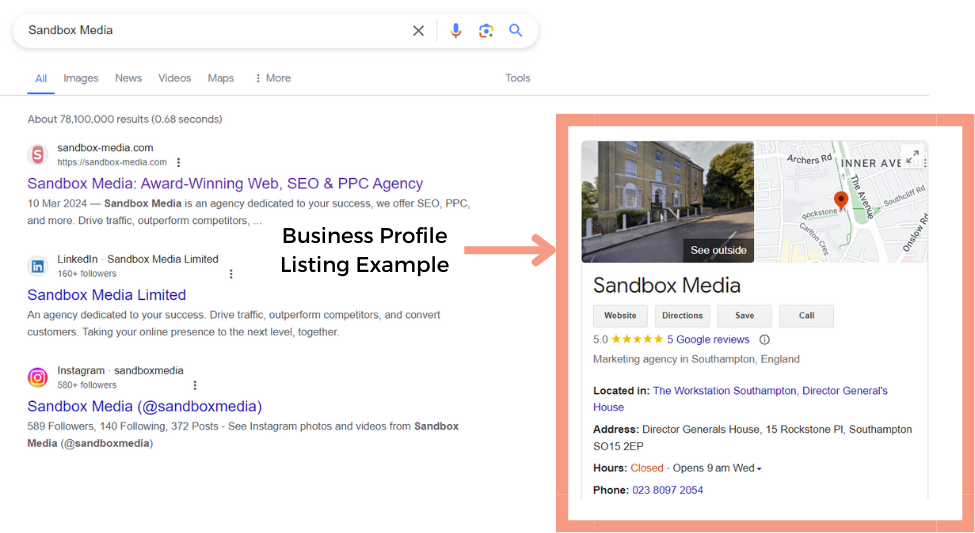If your business is location-based, you need to read this.
You could be missing out on hundreds of potential customers who are looking for your local business.
As the name suggests, Local SEO (Search Engine Optimisation) is focused on boosting search rankings local to a chosen area. It can be an incredibly effective means of boosting organic traffic to draw customers right to your business’s doorstep.
In this beginner-friendly guide, we’re going to discuss just how effective (…and simple) it can be to dominate your local area’s search engine results pages (SERPs) and skyrocket your Google Maps rankings.
What is Local SEO, & Why is it Important?
Local SEO refers to the process of optimising a business’s online presence to attract more local customers through search engines.
If Google believes the intent of a search is local, it will show local results. This is shown in the ‘local pack’ of results, which includes business listings and a map. This would come above organic results.
Let’s say you owned a restaurant and people were searching for ‘food near me’ or ‘restaurant near me’ in your area. If you were to consistently rank in the top 3 results (such as Nova Aesthetic Clinic) you’d be using local SEO to your advantage.
There are 3 main ways in which Google ranks a business locally:
- Distance – How far your business is from where the user has searched
- Relevance – How closely linked your Google Business Profile is to the word or phrase searched
- Authority – How helpful Google thinks the business will be to the user in fulfilling their search intent
Local SEO is especially important for businesses that serve specific geographic areas or have physical locations. Almost 50% of all Google searches come from people searching for local information.
You should optimise your business for local SEO, so you don’t miss out on people searching for your type of business in your area.
Aspects of Local SEO
Google My Business ‘Optimisation’
Google My Business (GMB) is a free tool that allows businesses to manage their online presence across various Google platforms, including Search and Maps.
GMB allows businesses to create and update their business information, such as NAP (Name, Address, Phone number), hours of operation, website URL, and business category. They can also interact with customers by responding to reviews, posting updates, and sharing photos.
It’s estimated that business listings with photos achieve 35% more clicks
Once you have created and verified your business on GMB, you should encourage your customers to leave reviews – positive reviews signal to Google that your business is credible and trustworthy, which contributes considerably to your ranking.
Not only does it signal to Google, but it also signals credibility to users – 88% of consumers look at reviews when discovering a local business.
Creating Local Content
Think about local content as the seasoning to your site – it gives it that extra kick to stand out.
Consider producing top-quality content that goes deeper than just promoting your products or services. Become the go-to expert in your field by promoting local industry events, and providing updates and informative content for your area.
This will separate your site from the rest.
There’s no doubt that content en masse has the potential to generate a certain amount of search volume but to attract local customers, it will always be more beneficial to write local-specific content.
As Google’s algorithms improve, you should focus on writing content that serves your users’ needs rather than solely pleasing the search engine.
Location Pages
Location pages can be very powerful in terms of local SEO, particularly for businesses with multiple locations. These pages include essential details such as address, phone number, business hours, directions, and any unique features or offerings specific to that location.
A well-optimised location page can help customers find and connect with their nearest location.
Avoid duplicating content across multiple location pages as this can lead to cannibalisation or ranking penalties. If you embed Google Maps to each location page, this can also signal the local importance of your business to Google, which improves local SEO.
Local Keywords
After conducting keyword research, you can add location-specific keywords to your location pages. This helps a business attract highly targeted traffic from users who are actively seeking products or services within their local vicinity. It also helps businesses to compete effectively in local markets, as these keywords help differentiate a business from larger, national competitors.
Links
Local Citation Building
Local citation building is often overlooked, and if you ask us, it’s one of the easiest ways to begin climbing the ladder of local SERP success.
But what exactly is local citation building?
Mentioning your business’s name, address, and phone number (NAP) in local business directories, industry-specific websites, and local publications contributes to building local citations.
Consistent NAP information across the net reinforces your business’s relevance and credibility in local searches.
Local Link Building
If you have read our “8 Benefits of Link Building in 2024” article on link building, you will know how important this step is in order to boost the authority of your site.
Local link building initiatives, such as partnerships with neighbouring businesses or sponsorships of local events, not only generate valuable backlinks but also strengthen your ties to the local community. This can also boost your local SEO efforts.
Technical SEO
Mobile Friendliness
Mobile and local search are very closely linked, with the vast majority of Google searches being performed on mobile.
Google prioritises mobile-friendly websites in its search results, which make up a significant portion of local queries.
A great way of visualising how your site appears on mobile is by using a mobile simulator. You can download our favourite mobile simulator here to view the pages on your site as you would on a mobile. Mobile users expect easy-to-use, fast loading websites.
Some common mistakes when it comes to poor mobile friendly sites include:
- Unresponsive design (fixed widths or elements that don’t adjust properly to smaller screens)
- Text hard to read (small font sizes)
- Lack of touch-friendly navigation (Complex navigation dropdowns that are not optimised for touchscreens)
- Slow loading times (Large images, excessive scripts, and unoptimised code)
- Poorly placed pop ups (Covering the main content or are difficult to dismiss)
Metadata Optimisation
Metadata is used to give users a deeper insight into a web page while they are still browsing the SERPs…think of them like an “elevated pitch”.
Optimising metadata is important to ensure the user is presented with enough relevant and useful information for them to deem your page worthy of a click, and for them to navigate further into your site.
However, we should also mention that recent Google updates now mean that meta description fields are sometimes automatically populated to present information from your site that is most relevant to the user search query.
Nevertheless, we believe that metadata optimisation is a quick and easy way to make sure no stone is left unturned when it comes to getting the local traffic lining up at your doorstep!
Optimising technical aspects such as title tags, meta descriptions, and header tags can improve the visibility, click-through rates, and overall performance of your website in local search engine results.
Social Media
Being active on platforms like Facebook, Twitter, and Instagram allows businesses to connect with their local audience and showcase their products or services to a wider community.
Engaging with followers, responding to comments, and sharing local news or events not only strengthens relationships with customers but also signals to search engines that the business is relevant and trusted within the local area.
Social media interactions can lead to increased website traffic and mentions of your business, which can positively impact local search rankings.
Conclusion
So, there you have it – a crash course in local SEO that’s sure to put your business on the map!
With so many potential customers just a search away, why leave your local presence to chance?
This is where we can help. Learn more about what we do and how we can help you drive your company’s success by boosting your local SEO rankings.
FAQs
What is a Google My Business Profile?
A Google My Business (GMB) profile is a free business listing that appears when users search for a specific business or category on Google Search and Maps. It provides essential information about a business, such as its name, address, phone number (NAP), website URL, hours of operation, and directions.
Businesses can claim and manage their GMB profiles through the Google My Business dashboard, which allows them to update and maintain accurate information, respond to customer reviews, post updates, photos, and promotions, and gain insights into how customers interact with their listing.
How do I get my business on Google Maps?
Firstly you create your Google Business Profile, and then verify your local business. Then, you make your profile one of a kind by filling out as much information about your business as possible such as your address, opening hours etc. Finally, you then optimise your profile for Google Maps by adding attributes (what makes your business unique) and reviews.
Having your Google Business Profile optimised is key for organic traffic, which is where we can also assist! Gain an insight into what we do, to help you drive organic growth.
How does local SEO differ from traditional SEO?
Traditional SEO aims to improve the visibility of your site on a more general and global scale, whereas local SEO targets specific geographic locations. It emphasises local keywords, local content, and optimisation of Google My Business profiles to enhance visibility in local search results.
How long will local SEO take to work?
The timeframe for seeing results from local SEO efforts can vary depending on various factors such as the competitiveness of the industry, the level of optimisation, and the effectiveness of the strategies used.
Generally, businesses may start seeing improvements in local search rankings within a few weeks to several months after implementing local SEO tactics. However, continuous monitoring and adjustment of the strategy may be required for long term results.
How can I improve my local search rankings without a physical location?
Even businesses without a physical location can benefit from local SEO by targeting specific geographic areas or regions where their target audience lives.
They can create location-specific landing pages, use local keywords, and participate in community events or sponsorships to improve local search visibility.












